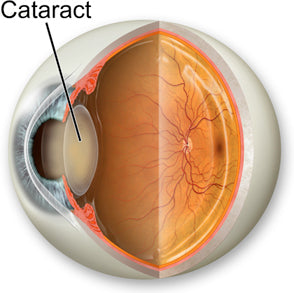Cataracts
Cataract surgery is the most frequent surgery performed annually in the United States. Yet, there are several myths regarding cataract surgery. For example, a cataract is not a veil that grows over the eye. Nor is it a new growth inside the eye.

Every eye has a lens in its center that helps to focus light and images on the retina, the inner lining of the eye. When we are born, that lens is perfectly clear and soft like gelatin. As we age, the lens becomes harder and less clear. Exposure to ultraviolet light and diseases such as diabetes may hasten that process.
When the lens is sufficiently opaque to obstruct vision, the lens is then said to be "cataractous", or more simply, a cataract. The trick to cataract surgery, then, is how to get a lens that is slightly less than one-half inch wide out of the eye and still allow the patient to see well.
When cataract surgery was first being developed, a large surgical opening was made, the cataract was taken out in one piece, and the wound was sewn shut. The problem with these early surgeries was that when the cataract lens was removed, nothing was put back into the eye to take its place. And without a lens inside the eye, even a cataractous lens, the vision was blurred. In order to make the vision clear, patients required thick eyeglasses or contact lenses after the surgery, to replace the function of their previous lens.
Eye surgery made a great advance when, after removing the cataract lens, a replacement lens was put back into the eye where the cataract previously resided. This is called a lens implant, and early intraocular lenses were made from hard acrylics.
The most recent advance in cataract surgery is "laser-assisted, no-stitch" or small incision cataract surgery. In this procedure, a small probe is placed inside the eye through a wound that is only one-eighth of an inch in diameter. Computer-guided light beam is used to sever the cataract into small pieces, and high-energy sound waves ultrasound vacuum those pieces away. Because the lens is being dissolved, or emulsified, this procedure is known as phacoemulsification. The lens implants that are then put in are foldable, enabling them to fit through the one-eighth inch wound, but then unfolding inside the eye to their full half-inch size.
The magic to modern cataract surgery is that it allows removal of a half-inch lens through a one-eighth inch opening.
Laser-Assisted Cataract Surgery through a small incision offers patients many benefits. Because the wound is exceedingly small, often there are no stitches that can cause irritation. The small wound is strong and water tight, allowing for participation in full activities immediately after the surgery. And lastly, because the small wound doesn't drastically alter the shape of the eye, the vision often is perfectly clear much sooner than surgeries with large surgical wounds.
